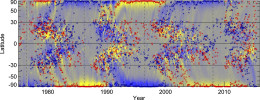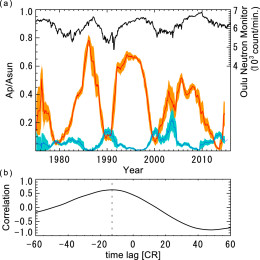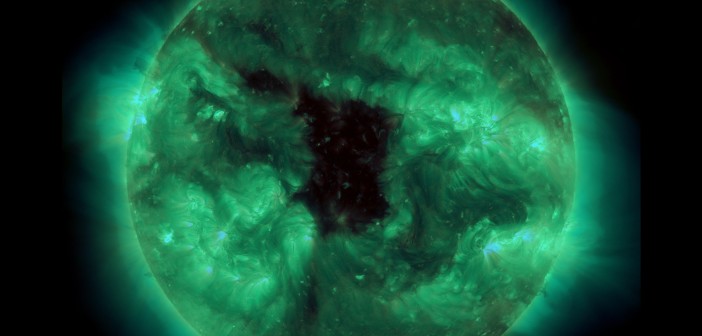Coronal holes are where the fast solar wind streams out of the Sun’s atmosphere, sending charged particles on rapid trajectories out into the solar system. A new study examines how the distribution of coronal holes has changed over the last 40 years.

Coronal holes form where magnetic field lines open into space (B) instead of looping back to the solar surface (A). [Sebman81]
Source of the Fast Solar Wind
As a part of the Sun’s natural activity cycle, extremely low-density regions sometimes form in the solar corona. These “coronal holes” manifest themselves as dark patches in X-ray and extreme ultraviolet imaging, since the corona is much hotter than the solar surface that peeks through from underneath it.
Coronal holes form when magnetic field lines open into space instead of looping back to the solar surface. In these regions, the solar atmosphere escapes via these field lines, rapidly streaming away from the Sun’s surface in what’s known as the “fast solar wind”.
Coronal Holes Over Space and Time
Automated detection of coronal holes from image-based analysis is notoriously difficult. Recently, a team of scientists led by Ken’ichi Fujiki (ISEE, Nagoya University, Japan) has developed an automated prediction technique for coronal holes that relies instead on magnetic-field data for the Sun, obtained at the National Solar Observatory’s Kitt Peak between 1975 and 2014. The team used these data to produce a database of 3335 coronal hole predictions over nearly 40 years.

Latitude distribution of 2870 coronal holes (each marked by an x; color indicates polarity), overlaid on the magnetic butterfly map of the Sun. The low-latitude coronal holes display a similar butterfly pattern, in which they move closer to the equator over the course of the solar cycle. Polar coronal holes are more frequent during solar minima. [Fujiki et al. 2016]
Predicting the Impact of the Solar Wind
Why do these observations matter? Coronal holes are the source of the fast solar wind, so if we can better predict the frequency and locations of coronal holes in the future, we can make better predictions about how the solar wind might impact us here on Earth.

Periodicity of high-latitude (orange) and low-latitude (blue) coronal-hole areas, and periodicity of galactic cosmic rays detected at Earth (black). The cosmic rays track the polar coronal-hole area behavior with a 1-year time lag. [Fujiki et al. 2016]
Polar coronal holes are therefore a useful observable indicator of the dipole component of the solar magnetic field, which modulates the incoming cosmic rays entering our solar system. This coronal hole database will be a useful tool for understanding the source of solar wind and the many ways the wind influences the Earth and our solar system.
Citation
K. Fujiki et al 2016 ApJ 827 L41. doi:10.3847/2041-8205/827/2/L41

